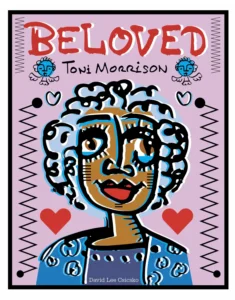 Francesca Lia Block believes that “the very best way to learn to write, and read, is to closely study fine writing”, which is why she chose “Beloved” by Toni Morrison as the text for One Story, Pocket MFA, and Antioch’s MFA program. She gave a few of her students (including me!) a chance to reflect on Toni Morrison’s life changing book in her substack “Lit Angels.” Gracias Francesca!
Francesca Lia Block believes that “the very best way to learn to write, and read, is to closely study fine writing”, which is why she chose “Beloved” by Toni Morrison as the text for One Story, Pocket MFA, and Antioch’s MFA program. She gave a few of her students (including me!) a chance to reflect on Toni Morrison’s life changing book in her substack “Lit Angels.” Gracias Francesca!by Mary Camarillo
I found Francesca Lia Block’s twelve craft questions extremely helpful in rereading Beloved by Toni Morrison. These craft questions center around character gifts, flaws, wants, needs, arc, antagonist, setting, style, crisis, climax, theme, and resolution. For the class exercises, I focused on the character Paul D. One of Paul D’s gifts is his ready smile, his ability to produce the feeling you were feeling, “the kind of man who can walk into the house and make the women cry.” He also has empathy and the strength to not let horrific abuse he’s experienced break him.,
Paul D’s flaw is being a man and as Baby Suggs says, “A man ain’t nothing but a man.” Although he tries not to, Paul D is attracted to Beloved, notices that she is “shining” like the quality of the leaves on a strawberry plant shine and gild before they form berries.
Paul D wants Sethe and tells her that when she first sees him sitting on her porch and asks if he came by for Baby Suggs. “That’s some of what I came for. The rest is you.” “We can make a life,” he tells Sethe.
Paul D has basic needs—a place to sit down, somewhere to sleep, to find work. Paul D also realizes when he first encounters the ghost in Sethe’s house that it’s probably best to move on. “If a Negro got legs he ought to use them.” Paul D has a deeper need to protect his heart. It’s risky, he believes to love anything too much, better to “love just a little bit…so when they broke its back or shoved it in a croaker sack, well, maybe you’d have a little love left over for the next one.”
In Paul D’s arc, he initially resists his attraction to Beloved but he is a man. His desire for a peaceful life with Sethe is challenged by this attraction to Beloved, the disdain Denver has for him, and by the ghost in Sethe’s house. Paul D is forced to leave Sethe‘s house.
Being an enslaved human being in the United States of America is the primary wound of each of these characters. Paul D’s resilience in surviving the abuse from his enslavers is a gift. As an enslaved human, he’s been denied the security of family and love which increases his want for Sethe. The horrific trauma he’s experienced has increased his need to protect his heart.
Paul D’s major antagonist is Beloved, who pushes him to change by moving him out of the house. “Paul D didn’t know how to stop it because it looked like he was moving himself.”
Despite Paul D’s love for Sethe, and despite his little tobacco tin heart being rusted shut, Beloved seduces him. “I want you to touch me on the inside part,” she says. I loved the imagery of Paul D’s fall from grace. “He didn’t hear the whisper that the flakes of rust made either as they fell away from the seams of his tobacco tin.” All he knows at the end is “when he reached the inside part he was saying, “Red hear. Red heart.”
The setting of the story provides when the house conspires with Beloved to move Paul D out. First, he falls asleep in the rocking chair instead of going up the stairs to sleep with Sethe. He’s amazed at how refreshed he feels but it doesn’t last. He sleeps in Baby Suggs room for a while, then the storehouse, and finally the cold room. He thinks he’s having “house fits,” “the glassy anger men sometimes feel when a woman’s house begins to bind them,” when they want to..run off.” But Paul D doesn’t want to run away from Sethe. He loves her a little bit more every day. And then he finds out what Sethe did and says something unspeakably cruel to her. “You got two feet, not four.” “And then a forest sprang up between them; trackless and quiet.”
It’s impossible to pick one favorite aspect of Morrison’s voice/style. She has the ability to make the magical real and the real magical. Her metaphors and imagery are powerful. The tin box of Paul D’s heart. The forest, which locks “the distance between them, giving it shape and heft. “So long,” Sethe murmurs to Paul D, “from the far side of the trees.” Morrison’s skill at shifting points of view without making the reader dizzy is equally amazing. The scene between Paul D and Sethe when she explains what happened shows us exactly how each character is feeling.
That crisis of the story (page 162) is right after Baby Suggs’ blackberry pie celebration when the community turns against Baby Suggs and her family. They’re jealous of Baby Suggs not having to escape slavery, being bought out of it instead. They’re angry about her generosity, of her being the center of everything. “The scent of their disapproval lay heavy in the air.” Baby Suggs knows something is wrong immediately and something is terribly wrong with a community that chooses not to warn Baby Suggs that the School Teacher and his slave catcher posse are on their way.
The first climax comes immediately after the posse arrives and finds Sethe in the woodshed, trying to kill her children. Morrison escalates the tension in a series of cascading events. Stamp Paid reads the newspaper article to Paul D which causes him to break from Sethe. Stamp Paid struggles with guilt for telling Paul D and decides to visit 124 to apologize, where he sees Beloved. Confused, he searches for Paul D and finds out he’s living in the church because the community has shunned him. Stamp Paid tells more of Paul D’s story. Meanwhile Sethe overhears Beloved hum a lullaby that only her children would know and believes Beloved is her reincarnated daughter. Denver has already recognized Beloved as her sister. Denver reveals more about what happened after Sethe tried to kill her children and we understand the terror Denver has experienced. Stamp Paid visits Paul D at the church and Paul D reveals more of his past. Stamp Paid thinks Beloved might be a woman who’s been trapped in a house with a white man her entire life. Paul D sees her as a ghost. How much is he supposed to take? All he can, Stamp Paid says. Why, Paul D asks, over and over.
Morrison also creates tension with her unexplained imagery and stream of consciousness narratives. All through the novel Morrison has dropped breadcrumbs of backstory, so the reader (me anyway) is on the lookout for what is not completely understandable because I assume it will eventually make sense and I keep reading to figure out what happened and what it means. For example: Page 212. Stamp Paid’s fascination with the red ribbon, “knotted around a curl wet wooly hair, clinging still to its bit of scalp.” “Reaching for it, he thought it was a cardinal feather stuck to his boat.” Stamp Paid drops the curl in the weeds but he keeps the ribbon and carries in his pocket. Whose scalp was it? Page 248. I think Beloved’s narrative describes what she saw after her death but I’m not sure. Who was the dead man on top of her. Why does she love his teeth? Regardless of what this means, I loved how the focus is always on Beloved watching Sethe, “a hot thing.” Page 277. Stamp Paid tells Paul D, “Was a girl locked up in the house with a white man over by Deer Creek. Found him dead last summer and the girl gone. Maybe that’s her.”
Maybe. Trying to apply logic to this, maybe Beloved wasn’t really dead when she was buried, was found by this white man and imprisoned by him the entire time. But it’s impossible to apply logic to a story about enslaved human beings because the entire concept is not logical.
The second climax of the story is when Sethe mistakes Bodwin for the Schoolteacher. In this scene Paul D is absent and hears about it later from Stamp Paid, in the second to last chapter. The second to last chapter begins with a poem about a Sweet Home gal making you lose your mind. As Paul D returns to the house, “His coming is the reverse route of his going. The house was Paul D’s antagonist but now it is peaceful and when he sees that the dog has also returned, Paul D knows Beloved is gone.
Some of the prior themes echo through the final pages. Paul D finds the brightly colored clothes and the ice skates and Beloved’s white dress. Sethe has gone to bed as Baby Suggs did, but she has a quilt of merry colors. Sethe remembers “the thing in him (Paul D) the blessedness that has made him the kind of man who can walk in a house and make the women cry.”
Paul D visits each room of the house looking for Sethe. The climax of this scene comes when he finds her, the resolution when he offers to care for her. “You’re your best thing,” he tells her. He also has a resolution with Denver. She is the first to smile. She is honest about her mother, telling him she’s “not a bit all right.” When he asks if she wants his opinion about Beloved she says, “I don’t. I have my own.” Morrison gives us a glimpse of Denver’s possibilities when a young man asks her to wait up. Paul D sees her face “looking like someone had turned up the as jet.
What I found unusual at this point in the novel is Morrison choice to include more of Paul D’s backstory. The period of time after the Civil War was an extremely violent part of American History and Paul D witnessed this horror. “The Yankees in control left the Rebels out of control.” “In five tries he had not had one permanent success,” but Paul D still cannot “help being astonished by the beauty of this land that was not his.” I especially loved Paul D’s memory of Six-o talking about his thirty-mile woman. “She gather me man. The pieces I am, she gather them and give them back to me in all the right order.
In thinking about the impact Morrison’s work has on my own writing–I found the 12-question approach very helpful, especially the questions on gifts, flaws, wants and needs. A frequent criticism of my work is that “what the character wants” is not clearly identified. I don’t always get the characters’ wants and needs out of my head and on the page. I admire Morrison’s skill in making the character’s innermost desires so clear. Another critique of my work is “who is the story about? Who are we supposed to root for?” I am in awe of how each of the characters in Beloved could be considered the main protagonist. Morrison is a master at illustrating the humanity of each character.
Something to strive for.

